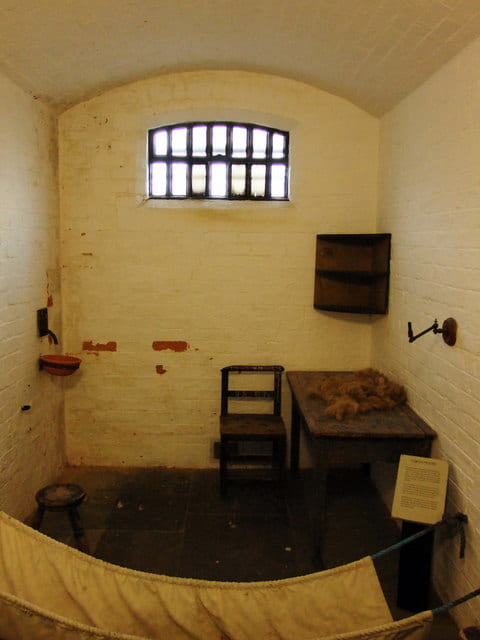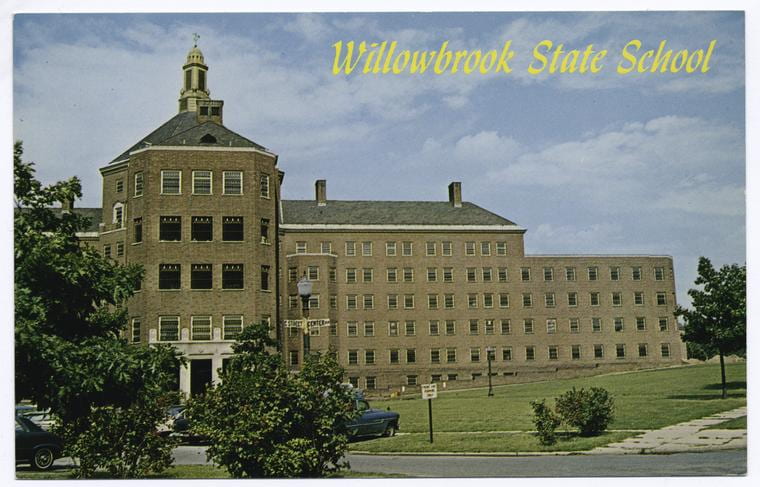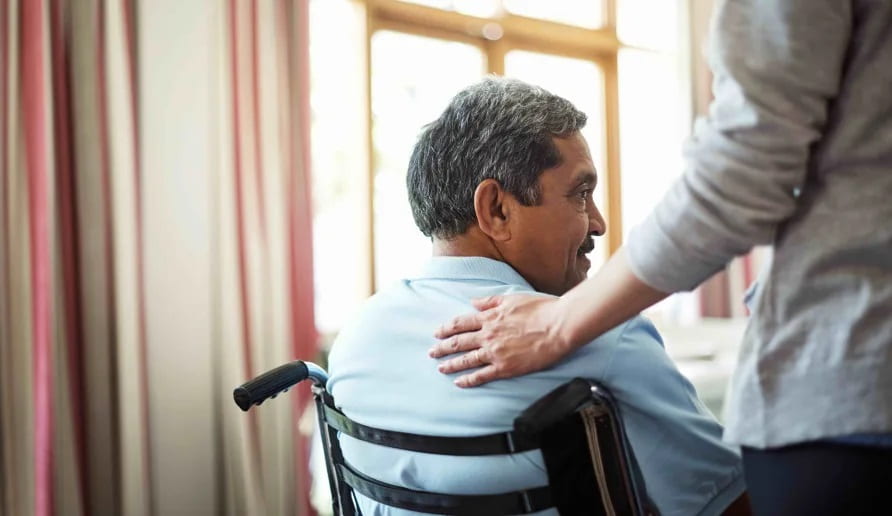by James DeLano
What Are Institutions for People with Disabilities?
In this post, I focus on the institutions that were, and remain, facilities operating for the purpose of housing people with disabilities. The National Council for Disability (NCD) defines these institutions as “a facility of four or more people who did not choose to live together.” They summarize a report made by a consortium of self-advocacy organizations based on their experiences with institutionalization. The NCD list of criteria to define an institution, as synthesized from various self-advocacy groups, is that they:
- Include only people with disabilities,
- Include more than three people who have not chosen to live together,
- Do not permit residents to lock the door to their bedroom or bathroom,
- Enforce regimented meal and sleep times,
- Limit visitors, including who may visit and when they may do so,
- Restrict when a resident may enter or exit the home,
- Restrict an individual’s religious practices or beliefs,
- Limit the ability of a resident to select or remove support staff,
- Restrict residents’ sexual preferences or activities,
- Require residents to change housing if they wish to make changes in the personnel who provide their support or the nature of the support,
- Restrict access to the telephone or Internet,
- Restrict access to broader community life and activities.
Historically, these kinds of institutions have primarily included people struggling with mental health and people with intellectual or developmental disabilities.
What Were America’s First Institutions for People with Disabilities?
Mental institutions in America predate the reality of an American nation. The earliest hospital for the mentally ill, the Publick Hospital for Persons of Insane and Disordered Minds, was founded in Virginia in 1773. It was closer to a prison than what we would now call a hospital; patients were kept chained and shackled, physically abused, intentionally fed rotten food, and bathed in ice water. Inmates were rarely released. Many were placed or kept in prisons prior to or after their evaluation as being “insane.” This began to change in the 1840s; a new medical director attempted to use more humane approaches to treatment. Those included treatment that was consented to and largely removing chains and shackles.
The first modern institution for disabled people was founded by Samuel Gridley Howe in 1848 in Boston, Massachusetts. It was considered experimental, despite others’ previous endeavors taken elsewhere, but Howe had experience in a similar environment, having founded the Perkins Institution for the Blind twenty years earlier. A contemporary article sings praises of the institution. Despite that, the electronic catalog of annual reports by the institution, renamed the Walter E. Fernald State School, ends abruptly in 1973 with a report on identifying child abuse and neglect.

John F. Kennedy
John F. Kennedy (JFK) played an important role in the early reform of institutions for people with disabilities. Many people know that Kennedy’s sister, Rosemary, was lobotomized, leaving her permanently disabled and confined to a psychiatric institution. Lesser known is that Kennedy established the President’s Panel on Mental Retardation in 1961, the first government committee on the topic. The committee’s recommendations led to numerous regulations being changed and legislation being passed. One Panel member, Eunice Shriver, who was also Kennedy’s sister, went on to found the Special Olympics.
Institutions for People with Disabilities in Alabama
The first mental hospital in Alabama was the Alabama Insane Hospital, founded in 1859 and renamed to Bryce Hospital in 1900. Ricky Wyatt, at the time 15 years old, was committed by a court to Bryce in 1969. He was not mentally ill.
Wyatt’s institutionalization led to a widespread deinstitutionalization movement. His guardian, a former employee of the hospital, sued Bryce Hospital on his behalf. During the discovery process, Wyatt’s lawyers discovered numerous preventable deaths in the facility, as well as a complete lack of plans in case of a fire; there was no way to contact the Tuscaloosa fire department after 5:00 PM, and the fire hydrants on the property were decades old and incompatible with modern firefighting equipment.
That lawsuit, Wyatt v. Stickney (1972), was part of the beginning of a legal deinstitutionalization movement. It created a minimum standard for care at Alabama institutions for the mentally ill.
Willowbrook State School
Willowbrook was a state-funded institution in Staten Island from the 1940s until the late 1980s. The school was over its capacity in only a few years; in 1965, Robert Kennedy described Willowbrook as a “snake pit” with “rooms less comfortable and cheerful than the cages we put animals in a zoo.” The few changes that resulted from Kennedy’s visit were insubstantial and short-lived.
Another infamous incident in Willowbrook’s history was the hepatitis experiment conducted on the children in residence. The exact rate of hepatitis infection in children at Willowbrook is unknown; I have seen estimates ranging from 30% to 90% of children becoming infected during their time at Willowbrook. At the time, many specific details of hepatitis were unknown. Willowbrook had a local strain of hepatitis that was reputed to be less lethal than strains common elsewhere. Saul Krugman, funded in part by the U.S. Surgeon General’s Office, began conducting a study on hepatitis in Willowbrook – initially starting with an epidemiological focus, then shifting to a more involved study. Krugman intentionally infected 60 children at Willowbrook with the hepatitis virus by feeding them live samples of the hepatitis virus. Krugman “watched as their skin and eyes turned yellow and their livers grew bigger.”
Willowbrook left the public consciousness almost entirely until 1972, when Geraldo Rivera created a bombshell documentary that exposed the conditions at Willowbrook State School and institutions like it. In March 1972, residents’ parents filed a class-action lawsuit alleging violations of the constitutional rights of Willowbrook residents. Just three years later, as a result of the lawsuit, the Willowbrook Consent Decree created standards the institution would be Willowbrook open, however; Willowbrook State School formally closed “officially and forever” on September 17th, 1987.

Despite the promise made in the wake of the Willowbrook scandal, alumni are still mistreated today. In 2020, The New York Times published the results of an investigation conducted into recent abuses in a group home in New York where some Willowbrook alumni resided. They describe physical abuse and neglect, including injuries caused by scalding water, deaths caused by neglect, and ant infestations. The investigation made allegations against 13 employees, nine of whom still worked for the agency, and seven of those still worked in group homes at the time of the article’s publishing.
Institutions for People with Disabilities Today
In 2018, the Office of the Inspector General (OIG), along with other federal agencies, published a report on group homes, which have largely succeeded large institutions like Willowbrook or Bryce. They found that, in 49 states, health and safety procedures were not being followed.
“OIG found serious lapses in basic health and safety practices in group homes. OIG made multiple referrals to local law enforcement to address specific incidents of harm.”
Between 2004 and 2010, 1,361 people with disabilities died in Connecticut. 82 of those deaths were caused by neglect or abuse. The causes were found to be due to “abuse, neglect, and medical errors.” The OIG found that “State agencies did not comply with Federal waiver and State requirements for reporting and monitoring critical incidents.” These “critical incidents” include deaths, assaults, suicide attempts, and missing persons.

While we, as Americans, often like to think our country has advanced for people with disabilities, the reality is disappointing. Willowbrook alumni are still being abused forty years later. Group homes have been found to have widespread abusive and neglectful practices.
State Protection & Advocacy agencies exist as a legal protection for people with disabilities. In Alabama, the Alabama Disability Advocacy Program provides legal assistance to people with disabilities in cases involving civil rights violations and has the ability to investigate said cases in hospitals, group homes, schools, and any other facilities where abuse or neglect of people with disabilities occurs.
